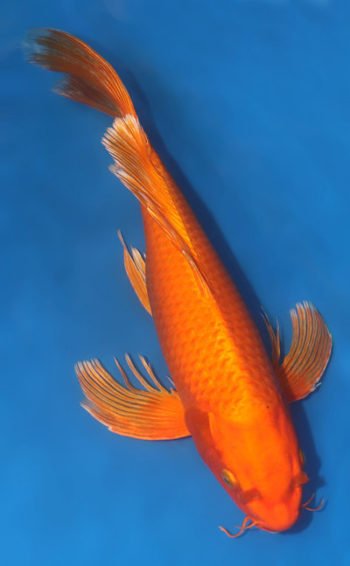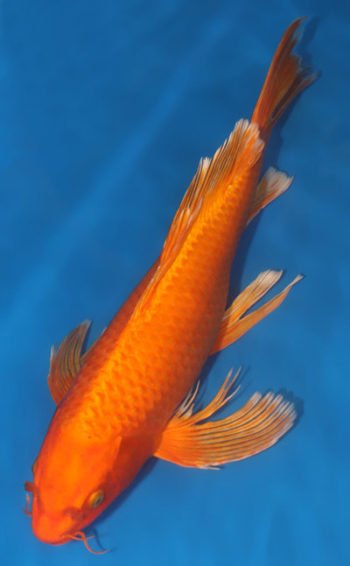Description
Hirenaga Orange Ogon Koi For Sale
Hirenaga Orange Ogon Koi, there are so many names for this variety — hirenaga (“long fin”), onaga (“long tail”), tenaga (“long arm”) and hagoromo (“celestial robe of an angel”) are just a few. I like to use Hirenaga, because it is the most commonly used.
Unfortunately, Hirenaga did not gain much popularity in Japan. Instead, it became very popular overseas. In the United States, for example, there are Hirenaga divisions at koi shows, while there are none in Japan. I believe this stems from the different aesthetic senses of each culture. Because their fins are long, they are easy to split or tear. Personally, I think this imperfection might have bothered the Japanese eye.
However, I must admit that Hirenaga have made a very big contribution to the koi world. Because Hirenaga blood can be introduced to any variety, it literally doubles the varieties of Japanese koi.
Identification
Appreciation of Hirenaga is very simple. Though the long fin is its main characteristic, the shape and beauty of the fin is the most important part. After this has been identified, we can check the koi according to the standards of each variety.
When you look at the fins, ideally they should be long and symmetrical with no tears. Take a look at the examples in the pictures. Due to the high difficulty of breeding ideal, long fins, it should not be criticized too much. But I believe these examples should give you an idea of what to look for. After checking the shape of fins, the standards of each variety need to be checked. For example, koi A is a Tancho Sanke. So, we need to examine the shape of the circle on its head. The quality and location of the sumi are important in the Sanke variety.
Although Hirenaga are not popular in Japan, there are two excellent breeders in Niigata. If you consider the fact that more than 80 percent of Japanese Koi are exported, it seems natural that some breeders want to breed quality Hirenaga.
Koi Care Guide – Six things to know about your koi
- Experience Level: Intermediate
- Size: Koi grow up to 36 inches (91 cm) long
- Lifespan: They can live for more than 50 years and thrive in a wide range of water temperatures
- Temperament: They are generally peaceful but may pick on slower fish
- Origin: They’re a type of carp native to Japan
- Did You Know: Koi can learn to recognize and take food from their pet parents
How do I set up my koi’s aquarium?
- Koi grow quickly and get very large. Keep mature koi in an outdoor pond of at least 3 feet deep, with at least 50 gallons of water per fish.
- Young koi can be kept indoors in an aquarium of at least 29 gallons.
- Put the aquarium in a quiet area out of direct sunlight and drafts.
- Cover the aquarium with a hood to reduce evaporation and splashing and to keep fish from leaping out.
- To transfer new koi to the aquarium, float them in the water inside their bag for about 10 minutes so they can acclimate to the new water temperature.
- If you’re introducing koi to an existing school in an aquarium or pond, quarantine the new fish in a separate body of water for 2 to 4 weeks to be sure they are healthy.
- On moving day, use a net to transfer the koi so old water doesn’t mingle with new water.
- Whether they live indoors or outdoors, add no more than 3 new koi at a time.
Heat & light
Outdoor koi are hardy and will hibernate under ice in winter as long as their pond is deep enough to not freeze completely. (They won’t survive in solid ice.)
Your koi’s pond should be partially shaded.
Indoor koi prefer water between 65 and 75 degrees Fahrenheit.
Install a light inside an indoor aquarium to illuminate it for 8 to 12 hours a day.
Water temperature
Koi are pretty temperature-resistant— they can even hibernate under ice in winter. Just be sure your pond is at least three feet deep— otherwise, it could freeze solid, and koi aren’t that tough. When they live indoors, koi prefer cool water—between 65 and 75 degrees F (18 to 24 C).
How do I keep my koi healthy?
If your outdoor koi don’t seem to be eating in the winter, don’t worry; it’s normal for them to stop eating at temperatures below 40 F. Be sure to contact a veterinarian if you notice any of these symptoms:
- Unusual swimming pattern
- Thinness or decreased appetite
- Abdominal swelling
- Inflamed or discolored skin or fins
- Fins clamped to sides of body
- Scraping body on rocks (flashing)
types of koi fish, koi fish, koi fish price, koi fish pond, koi fish meaning, koi fish for sale, koi fish drawing, koi fish care, koi fish for sale online, butterfly koi for sale, koi fish for sale near me, big koi for sale, buy koi fish cheap, koi fry for sale usa, types of koi fish, koi fish for sale, High Quality Koi, Coy fish, coe fish, butterfly koi, types of koi, kodama koi, black koi, ogon koi, doitsu koi, tancho koi, butterfly koi varieties
 Aigoromo Koi 18.11 inch
2 × $250.00
Aigoromo Koi 18.11 inch
2 × $250.00  Doitsu Showa Koi
2 × $140.00
Doitsu Showa Koi
2 × $140.00  Doitsu Showa Koi 15.35 inch
1 × $150.00
Doitsu Showa Koi 15.35 inch
1 × $150.00  Doitsu Ginrin Soragoi Koi
2 × $130.00
Doitsu Ginrin Soragoi Koi
2 × $130.00  Doitsu Sanke Koi
1 × $200.00
Doitsu Sanke Koi
1 × $200.00  Asagi Koi 21.26 inch
1 × $200.00
Asagi Koi 21.26 inch
1 × $200.00 



Reviews
There are no reviews yet.